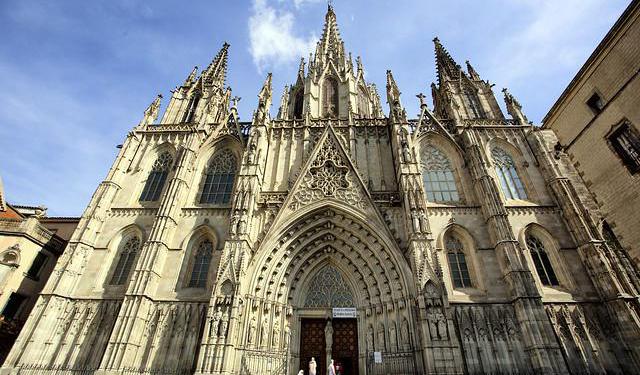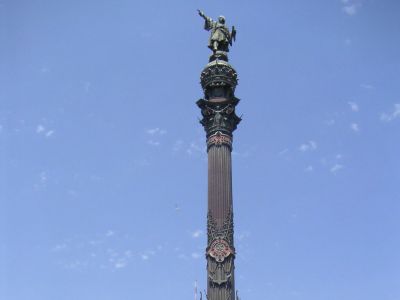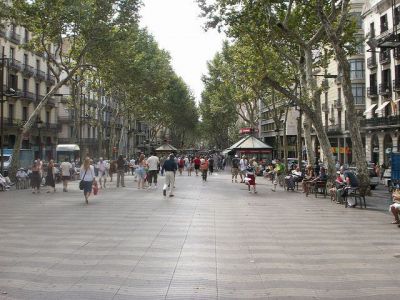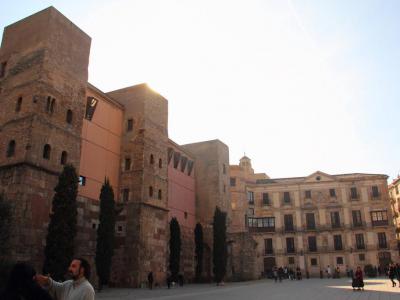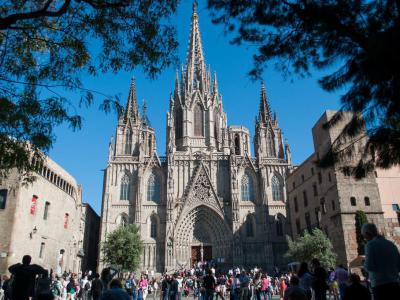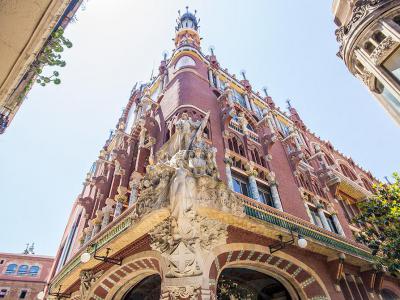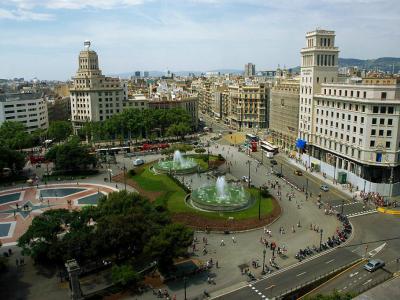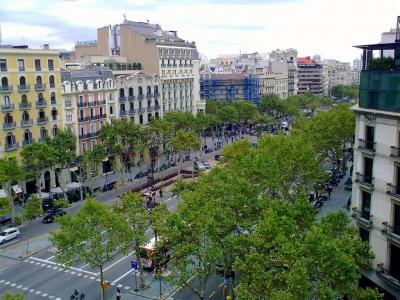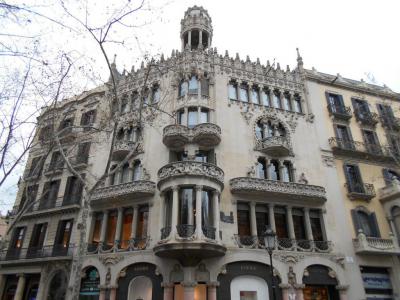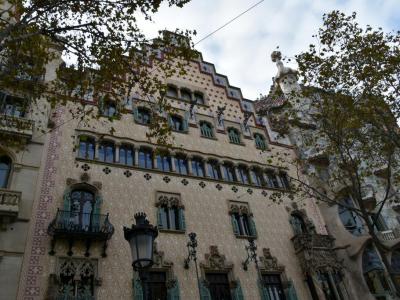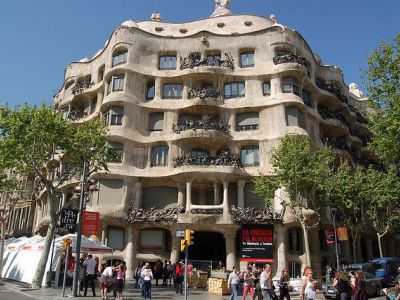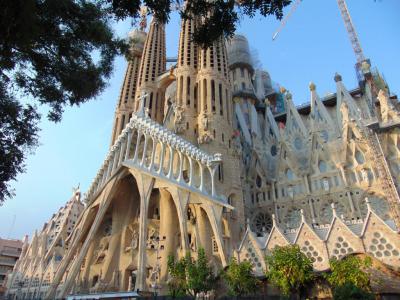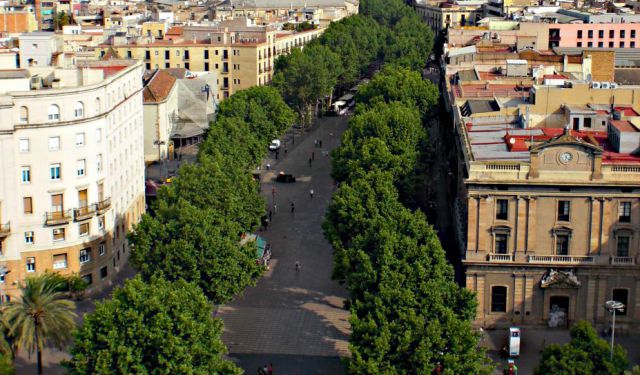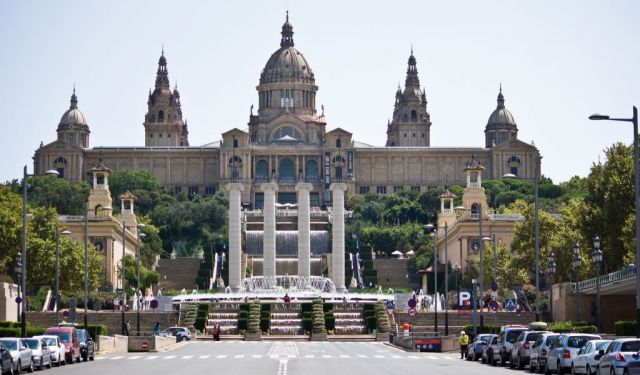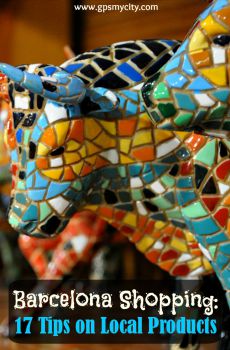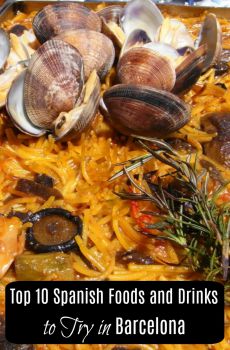Audio Guide: Barcelona Introduction Walking Tour (Self Guided), Barcelona
According to legend, Barcelona was founded by the mythological Greek hero Hercules on one of his expeditions, when a storm hit his boats. The first eight boats managed to escape without damage, but the ninth was lost at sea. Hercules found his lost friends some days later on the coast, all safe and sound. The boat's crew, taken by the beauty of the coastal landscape, decided to stay. On that coast, Hercules and his men founded a settlement that they called “Barca Nona” or the “Ninth Boat”.
Somewhere around the year 15 BC, the Romans established a military outpost – on the hill adjacent to the present-day city hall. In the Middle Ages, Barcelona merged with the Kingdom of Aragon as its economic and administrative center and later established itself as the capital of the Principality of Catalonia. Between the 13th and 15th centuries, Barcelona emerged as the Western Mediterranean's financial and political hub. The city's Gothic Quarter bears witness to the splendor of that period.
Today, Barcelona is a dynamic metropolis and tourist mecca. A great place to start exploring it is the iconic Columbus Monument standing at the lower end of La Rambla, a lively street bustling with shops, cafes, and street performers. At the upper end of it lies La Boqueria, a vibrant marketplace filled with fresh produce, local delicacies, and an array of colors that captivate the senses.
Strolling along La Rambla, halfway through, slightly tucked away from view, you will find the Güell Palace. One of the architectural gems designed by Antoni Gaudí, this building showcases his early mastery in blending functional design with modernist aesthetics.
Indeed, the prime attraction for which Barcelona is renowned internationally is architecture. Moving towards New Square, you are greeted by the majestic Barcelona Cathedral, a Gothic masterpiece and a testament to the city’s medieval grandeur.
On the upscale Gràcia Boulevard, the elegant facades of Batllo and Mila houses stand out as some of the finest examples of modernist architecture. Art enthusiasts shouldn’t miss the Palace of Catalan Music, an architectural marvel known for its intricate detailing and vibrant stained glass.
Finally, no visit to Barcelona is complete without seeing the world-famous La Sagrada Família Basilica, an architectural wonder that has been under construction for over a century.
Barcelona is a city that invites you to explore its streets, soak in its artistic spirit, and be captivated by its unique blend of history and modernity. So, pack your bags, bring your curiosity, and let Barcelona's magic unfold before your very eyes!
Somewhere around the year 15 BC, the Romans established a military outpost – on the hill adjacent to the present-day city hall. In the Middle Ages, Barcelona merged with the Kingdom of Aragon as its economic and administrative center and later established itself as the capital of the Principality of Catalonia. Between the 13th and 15th centuries, Barcelona emerged as the Western Mediterranean's financial and political hub. The city's Gothic Quarter bears witness to the splendor of that period.
Today, Barcelona is a dynamic metropolis and tourist mecca. A great place to start exploring it is the iconic Columbus Monument standing at the lower end of La Rambla, a lively street bustling with shops, cafes, and street performers. At the upper end of it lies La Boqueria, a vibrant marketplace filled with fresh produce, local delicacies, and an array of colors that captivate the senses.
Strolling along La Rambla, halfway through, slightly tucked away from view, you will find the Güell Palace. One of the architectural gems designed by Antoni Gaudí, this building showcases his early mastery in blending functional design with modernist aesthetics.
Indeed, the prime attraction for which Barcelona is renowned internationally is architecture. Moving towards New Square, you are greeted by the majestic Barcelona Cathedral, a Gothic masterpiece and a testament to the city’s medieval grandeur.
On the upscale Gràcia Boulevard, the elegant facades of Batllo and Mila houses stand out as some of the finest examples of modernist architecture. Art enthusiasts shouldn’t miss the Palace of Catalan Music, an architectural marvel known for its intricate detailing and vibrant stained glass.
Finally, no visit to Barcelona is complete without seeing the world-famous La Sagrada Família Basilica, an architectural wonder that has been under construction for over a century.
Barcelona is a city that invites you to explore its streets, soak in its artistic spirit, and be captivated by its unique blend of history and modernity. So, pack your bags, bring your curiosity, and let Barcelona's magic unfold before your very eyes!
How it works: Download the app "GPSmyCity: Walks in 1K+ Cities" from Apple App Store or Google Play Store to your mobile phone or tablet. The app turns your mobile device into a personal tour guide and its built-in GPS navigation functions guide you from one tour stop to next. The app works offline, so no data plan is needed when traveling abroad.
Barcelona Introduction Walking Tour Map
Guide Name: Barcelona Introduction Walking Tour
Guide Location: Spain » Barcelona (See other walking tours in Barcelona)
Guide Type: Self-guided Walking Tour (Sightseeing)
# of Attractions: 14
Tour Duration: 3 Hour(s)
Travel Distance: 5.7 Km or 3.5 Miles
Author: DanaOffice
Sight(s) Featured in This Guide:
Guide Location: Spain » Barcelona (See other walking tours in Barcelona)
Guide Type: Self-guided Walking Tour (Sightseeing)
# of Attractions: 14
Tour Duration: 3 Hour(s)
Travel Distance: 5.7 Km or 3.5 Miles
Author: DanaOffice
Sight(s) Featured in This Guide:
- Mirador de Colom (Columbus Monument)
- La Rambla
- Palau Guell (Guell Palace)
- Mercat de la Boqueria (La Boqueria Market)
- Placa Nova (New Square)
- Catedral de Barcelona (Barcelona Cathedral)
- Palau de la Musica Catalana (Palace of Catalan Music)
- Placa de Catalunya (Catalonia Square)
- Passeig de Gracia (Gracia Avenue)
- Casa Lleo Morera (Lleo Morera House)
- Casa Amatller (Amatller House)
- Casa Batllo (Batllo House)
- Casa Mila (Mila House)
- La Sagrada Familia (Basilica of the Holy Family)
1) Mirador de Colom (Columbus Monument)
The 60-meter Columbus Monument at the lower end of Barcelona's La Rambla was built for the 1888 Barcelona Universal Exposition. Honoring Christopher Columbus’ first voyage to the Americas, the monument symbolizes his return to Barcelona, upon which he reported to Queen Isabella I and King Ferdinand V.
The structure features a 7.2-meter bronze statue of Columbus atop a 40-meter Corinthian column. Originally intended to face west, towards the Americas, Columbus is instead depicted pointing east – reportedly towards his birthplace of Genoa, Italy. Others, however, believe that it simply strikes a dramatic pose toward the sea, symbolizing Columbus’ achievements in naval exploration. The statue stands on a base inscribed with the word "Tierra," which means “land”. Below it, the column is supported by an octagonal pedestal adorned with bronze victories, griffins, and medallions representing figures related to Columbus.
The pedestal’s base includes sculptures of historical figures, such as cartographer Jaume Ferrer and Catholic preacher Father Bernat de Boïl, along with bas-relief panels that illustrate significant moments from Columbus’ voyage, including his departure from Palos de la Frontera and his meeting with the King and Queen in Barcelona. Additionally, the monument’s base features coats-of-arms from locations that Columbus visited, such as Puerto Rico and Cuba.
The idea for the monument originated in 1856. Funded mostly through private donations, it was completed in 1888. The monument is exclusively a Catalan endeavor, with all the labor and materials sourced from the region, thus symbolizing the Catalans' recognition of Christopher Columbus as one of their own, despite his Italian origins.
Tip:
Take the time to go around the monument and observe the sculptures showcased at its base.
Inside the column, visitors can take an elevator to a viewing platform for a sweeping panorama of the surrounding area.
Also, check out the wine bar at the monument's cellar and a boutique offering unique souvenirs and gifts that surpass the mass-produced items found at street vendors.
A combined ticket for both the lift ride and wine tasting can be obtained at the base of the monument.
Viewing Platform:
Daily: 8:30 am–2:30 pm
The structure features a 7.2-meter bronze statue of Columbus atop a 40-meter Corinthian column. Originally intended to face west, towards the Americas, Columbus is instead depicted pointing east – reportedly towards his birthplace of Genoa, Italy. Others, however, believe that it simply strikes a dramatic pose toward the sea, symbolizing Columbus’ achievements in naval exploration. The statue stands on a base inscribed with the word "Tierra," which means “land”. Below it, the column is supported by an octagonal pedestal adorned with bronze victories, griffins, and medallions representing figures related to Columbus.
The pedestal’s base includes sculptures of historical figures, such as cartographer Jaume Ferrer and Catholic preacher Father Bernat de Boïl, along with bas-relief panels that illustrate significant moments from Columbus’ voyage, including his departure from Palos de la Frontera and his meeting with the King and Queen in Barcelona. Additionally, the monument’s base features coats-of-arms from locations that Columbus visited, such as Puerto Rico and Cuba.
The idea for the monument originated in 1856. Funded mostly through private donations, it was completed in 1888. The monument is exclusively a Catalan endeavor, with all the labor and materials sourced from the region, thus symbolizing the Catalans' recognition of Christopher Columbus as one of their own, despite his Italian origins.
Tip:
Take the time to go around the monument and observe the sculptures showcased at its base.
Inside the column, visitors can take an elevator to a viewing platform for a sweeping panorama of the surrounding area.
Also, check out the wine bar at the monument's cellar and a boutique offering unique souvenirs and gifts that surpass the mass-produced items found at street vendors.
A combined ticket for both the lift ride and wine tasting can be obtained at the base of the monument.
Viewing Platform:
Daily: 8:30 am–2:30 pm
2) La Rambla (must see)
Pulsating with energy, particularly during the peak tourist season, La Rambla is the most famous street in Barcelona and one of Europe’s most lively urban promenades. Stretching 1.2 kilometers from Catalonia Square to the Christopher Columbus Monument at the Old Port, it cuts through the Gothic Quarter and El Raval neighborhoods. Legendary Spanish poet Federico García Lorca famously described this bustling thoroughfare, teeming with colorful shops, charming pavement cafes, souvenir kiosks, and an eclectic mix of visitors, as “the only street in the world which I wish would never end.”
La Rambla is composed of several smaller sections, known collectively as “Les Rambles.” These include Canaletes Rambla, known for its fountain; Rambla of Studies, the site of a former Jesuit university; Rambla of Saint Joseph, home to a flower market; Rambla of the Capuchins, featuring the Liceu opera house; and Rambla of Santa Mònica, named after a local convent.
Originally a sewage-filled stream, La Rambla’s name comes from the Arabic word for "sand," dating back to the times when it functioned as a rainwater drain. By the late 14th century, the city expanded its walls to include La Rambla, which later transformed into a lively promenade.
Over time, La Rambla became a hub for festivals and commerce. Trees were planted along its path in 1703, with plane trees, in particular, added in 1859. Notable local landmarks include the Liceu Grand Theatre, Barcelona's renowned opera house, and the Palace of the Viceroy, a Baroque mansion now hosting exhibitions and events. The street also features a Joan Miró pavement mosaic and connects to the famous La Boqueria market, offering a plethora of local delicacies, as well as the Royal Square popular for its nightlife.
Prices at La Rambla are a bit steeper than elsewhere in the city, but then again, excitement comes at a price, and La Rambla sure gives tonnes of it.
Tip:
As you stroll along, remain vigilant against the occasional presence of pickpockets-keeping your eyes open is always a good idea.
For excellent food at more affordable prices and the opportunity to savor your meal in a relaxed setting, venture to the Santa Caterina market, just a 10-minute walk away from La Boqueria.
La Rambla is composed of several smaller sections, known collectively as “Les Rambles.” These include Canaletes Rambla, known for its fountain; Rambla of Studies, the site of a former Jesuit university; Rambla of Saint Joseph, home to a flower market; Rambla of the Capuchins, featuring the Liceu opera house; and Rambla of Santa Mònica, named after a local convent.
Originally a sewage-filled stream, La Rambla’s name comes from the Arabic word for "sand," dating back to the times when it functioned as a rainwater drain. By the late 14th century, the city expanded its walls to include La Rambla, which later transformed into a lively promenade.
Over time, La Rambla became a hub for festivals and commerce. Trees were planted along its path in 1703, with plane trees, in particular, added in 1859. Notable local landmarks include the Liceu Grand Theatre, Barcelona's renowned opera house, and the Palace of the Viceroy, a Baroque mansion now hosting exhibitions and events. The street also features a Joan Miró pavement mosaic and connects to the famous La Boqueria market, offering a plethora of local delicacies, as well as the Royal Square popular for its nightlife.
Prices at La Rambla are a bit steeper than elsewhere in the city, but then again, excitement comes at a price, and La Rambla sure gives tonnes of it.
Tip:
As you stroll along, remain vigilant against the occasional presence of pickpockets-keeping your eyes open is always a good idea.
For excellent food at more affordable prices and the opportunity to savor your meal in a relaxed setting, venture to the Santa Caterina market, just a 10-minute walk away from La Boqueria.
3) Palau Guell (Guell Palace) (must see)
Nestled in a discreet corner off the bustling La Rambla, the Güell Palace is an inaugural masterpiece of the architect Antoni Gaudí in Barcelona, which swiftly propelled him to international acclaim.
Now part of the UNESCO World Heritage Site called the "Works of Antoni Gaudí", this mansion was built between 1886 and 1888 for the industrial tycoon and Gaudí's lifelong patron, Eusebi Güell. The building showcases Gaudí's innovative use of iron supports as decorative elements, featuring twisted columns, arches, and intricate ceilings, topped with a whimsical array of tiled chimneys on the roof terrace.
Designed for high-society gatherings, the home’s central room has a tall ceiling, soaring three floors high, with a cupola. At night, to produce the appearance of a starlit sky, lanterns were hung from the outside through the small holes near the top. Arriving in horse-drawn carriages, guests entered the property through grand oval gates adorned with ironwork resembling seaweed. Horses were taken to a livery stable in the basement, while guests ascended to the receiving room. The walls and ceilings of this room contain discreet observation holes, allowing the owner to view guests from above before making an entrance.
With no budget constraints, Gaudí utilized the finest materials and craftsmanship to create a space that blends function and artistry seamlessly. This residence served as a preview of Gaudí’s future architectural innovations and his flair for combining structural elements with imaginative design.
Being slightly tucked away from the renowned La Rambla promenade, this lesser-known gem attracts fewer tourists, while offering a delightful opportunity to admire Gaudí's work in the charming old quarter of the city.
Tip:
The building's highlight is the rooftop terrace and its colorful chimneys adorned with mosaic and broken tiles. Note: on a rainy day, the rooftop may be closed, so it's advisable to check in advance the weather forecast to ensure a pleasant visit.
Now part of the UNESCO World Heritage Site called the "Works of Antoni Gaudí", this mansion was built between 1886 and 1888 for the industrial tycoon and Gaudí's lifelong patron, Eusebi Güell. The building showcases Gaudí's innovative use of iron supports as decorative elements, featuring twisted columns, arches, and intricate ceilings, topped with a whimsical array of tiled chimneys on the roof terrace.
Designed for high-society gatherings, the home’s central room has a tall ceiling, soaring three floors high, with a cupola. At night, to produce the appearance of a starlit sky, lanterns were hung from the outside through the small holes near the top. Arriving in horse-drawn carriages, guests entered the property through grand oval gates adorned with ironwork resembling seaweed. Horses were taken to a livery stable in the basement, while guests ascended to the receiving room. The walls and ceilings of this room contain discreet observation holes, allowing the owner to view guests from above before making an entrance.
With no budget constraints, Gaudí utilized the finest materials and craftsmanship to create a space that blends function and artistry seamlessly. This residence served as a preview of Gaudí’s future architectural innovations and his flair for combining structural elements with imaginative design.
Being slightly tucked away from the renowned La Rambla promenade, this lesser-known gem attracts fewer tourists, while offering a delightful opportunity to admire Gaudí's work in the charming old quarter of the city.
Tip:
The building's highlight is the rooftop terrace and its colorful chimneys adorned with mosaic and broken tiles. Note: on a rainy day, the rooftop may be closed, so it's advisable to check in advance the weather forecast to ensure a pleasant visit.
4) Mercat de la Boqueria (La Boqueria Market) (must see)
Situated to the north of La Rambla and a few blocks south of Catalonia Square, the Market of Saint Joseph de La Boqueria is extremely busy no matter what time of day or season you come. Colloquially referred to simply as La Boqueria, this large public market is one of Barcelona's foremost tourist landmarks with a broad choice of goods on offer.
Initially, the area was an unofficial extension of the New Square market. The name "Boqueria" possibly originates from the Catalan word "boc" for goat, indicating a place for selling goat meat. Indeed, the first mention of La Boqueria, as the meat market near the old city gate, dates back to 1217. By 1470, it was renamed “pig market” and afterward remained known as a straw market, up until 1794.
In 1826, the market gained an official status, and in 1835, plans were made for a formal structure on La Rambla. Construction began in 1840 and the market officially opened the same year. After several modifications, the building was inaugurated in 1853. A new fish market was added in 1911, and the current metal roof was installed in 1914, giving the market its present look.
Despite the constant flow of visitors, the experienced vendors efficiently handle the crowds, and the market's spacious layout helps ensure an enjoyable shopping experience. La Boqueria offers a fantastic opportunity to explore traditional Catalan cuisine. Here, you can take yourself on a tapas tour, sample exquisite jamón with cheese, purchase the world's freshest saffron (sold in various-sized small boxes), and enjoy local seafood (except for Sundays and Mondays when no fish is sold), plus discover many other culinary delights.
Also, don't miss the chance to try the freshly cooked fish at Kiosko Universal (a sit-down counter and bar-like place) or indulge in the wide variety of olives and delicious fresh fruits. Venture deep into the market to find the best stalls and taste a little bit of everything – you won't be disappointed.
Tip:
Keep in mind that the area is known for pickpocketing incidents, so whether you're alone or with friends, it is recommended to be vigilant and keep a close eye on your belongings.
Initially, the area was an unofficial extension of the New Square market. The name "Boqueria" possibly originates from the Catalan word "boc" for goat, indicating a place for selling goat meat. Indeed, the first mention of La Boqueria, as the meat market near the old city gate, dates back to 1217. By 1470, it was renamed “pig market” and afterward remained known as a straw market, up until 1794.
In 1826, the market gained an official status, and in 1835, plans were made for a formal structure on La Rambla. Construction began in 1840 and the market officially opened the same year. After several modifications, the building was inaugurated in 1853. A new fish market was added in 1911, and the current metal roof was installed in 1914, giving the market its present look.
Despite the constant flow of visitors, the experienced vendors efficiently handle the crowds, and the market's spacious layout helps ensure an enjoyable shopping experience. La Boqueria offers a fantastic opportunity to explore traditional Catalan cuisine. Here, you can take yourself on a tapas tour, sample exquisite jamón with cheese, purchase the world's freshest saffron (sold in various-sized small boxes), and enjoy local seafood (except for Sundays and Mondays when no fish is sold), plus discover many other culinary delights.
Also, don't miss the chance to try the freshly cooked fish at Kiosko Universal (a sit-down counter and bar-like place) or indulge in the wide variety of olives and delicious fresh fruits. Venture deep into the market to find the best stalls and taste a little bit of everything – you won't be disappointed.
Tip:
Keep in mind that the area is known for pickpocketing incidents, so whether you're alone or with friends, it is recommended to be vigilant and keep a close eye on your belongings.
5) Placa Nova (New Square)
Despite its name, New Square is the oldest square in Barcelona, founded in 1358. Until the 14th century, the area remained undeveloped, serving as a hay market behind the gates of the Roman settlement of Barcino.
New Square was built following a municipal council decision in 1355 to channel water from the Collserola mountains to the Square of Saint James. Throughout its history, the square has mostly kept its original name, except for a brief period, in the early 20th century, when it was renamed after Carlist Juan Vázquez de Mella.
The square has an irregular, triangular shape and, in the past century, was the site of several archaeological excavations. In 1994, the sculptural poem "Barcino" was installed, adding a modern touch to the area.
Several historical buildings surrounding the square include the medieval Baroque-style Bishop’s Palace and the Architects' Association of Catalonia building, featuring sand-cast friezes by Pablo Picasso. Other highlights are the remnants of the Roman wall and the gateway that once led to the ancient Forum, dating back to the 1st century BC and 4th century AD respectively. Two circular towers flanking the gate were added in the 12th century. Additionally, near the Archdeacon’s House, one can view fragments of the Roman aqueduct.
Tip:
Each Thursday, from 9 am to 8 pm, New Square hosts an antiques market.
New Square is also a venue for dance festivals – Sardanas, – particularly on the day of Saint Roch, a Majorcan Catholic confessor whose death is commemorated on 16 August.
New Square was built following a municipal council decision in 1355 to channel water from the Collserola mountains to the Square of Saint James. Throughout its history, the square has mostly kept its original name, except for a brief period, in the early 20th century, when it was renamed after Carlist Juan Vázquez de Mella.
The square has an irregular, triangular shape and, in the past century, was the site of several archaeological excavations. In 1994, the sculptural poem "Barcino" was installed, adding a modern touch to the area.
Several historical buildings surrounding the square include the medieval Baroque-style Bishop’s Palace and the Architects' Association of Catalonia building, featuring sand-cast friezes by Pablo Picasso. Other highlights are the remnants of the Roman wall and the gateway that once led to the ancient Forum, dating back to the 1st century BC and 4th century AD respectively. Two circular towers flanking the gate were added in the 12th century. Additionally, near the Archdeacon’s House, one can view fragments of the Roman aqueduct.
Tip:
Each Thursday, from 9 am to 8 pm, New Square hosts an antiques market.
New Square is also a venue for dance festivals – Sardanas, – particularly on the day of Saint Roch, a Majorcan Catholic confessor whose death is commemorated on 16 August.
6) Catedral de Barcelona (Barcelona Cathedral) (must see)
The Cathedral of the Holy Cross and Saint Eulalia, commonly known as Barcelona Cathedral, is a delightful combination of a church, mini-park, and a house of prayer, offering a serene alternative to the renowned La Sagrada Família. As the seat of the Archbishop of Barcelona, it was primarily constructed between the 13th and 15th centuries.
The cathedral has a pseudo-basilica layout with five aisles and a raised high altar. It is dedicated to Saint Eulalia, a young martyr whose relics are housed in the white marble sarcophagus inside the crypt. An intriguing feature is the presence of 13 geese in the cloister, symbolizing Saint Eulàlia's age at the time of her death.
Inside, the cathedral showcases choir stalls adorned with the coats-of-arms of the Order of the Golden Fleece. The Chapel of the Holy Sacrament contains a cross associated with the 1571 Battle of Lepanto and has been reconstructed to hold the tomb of San Olegarius, a former bishop of Barcelona.
The cathedral’s origins trace back to an early Christian and Visigothic complex that was damaged during a Muslim attack on Barcelona in 985. It was replaced with a Romanesque church in 1046 before the current Gothic cathedral began construction in 1298. The cathedral took 150 years to complete yet its neo-Gothic façade, featuring gargoyles and other mythical creatures, was finished only in 1913. Unlike many other churches in Barcelona destroyed during the Civil War, this Gothic temple was spared.
An exemplary piece of Catalan Gothic architecture, emphasizing balanced proportions over verticality, the cathedral measures 93 meters long, 40 meters wide, and 28 meters high at its central nave, with bell towers reaching 54 meters and the central peak at 70 meters.
The Cathedral of Barcelona is also famous for giving rise to the unique Catalan tradition of "dancing egg." Observed during the feast of Corpus Christi (also known as the Solemnity of the Most Holy Body and Blood of Christ), this tradition features an egg balanced on a water fountain’s jet.
The cathedral's cloister contains a gift shop. Cellular phones have been banned from the Chapel of Lepanto and other chapels. While exploring the cathedral's interior, make sure to venture up to the lofty roof terrace. You will be rewarded with views of the cathedral's towers, pinnacles, cimborio, and the Cloister, and a 360-degree view of the city!
Tip:
Cathedral Visit (including Choir entrance + Access to the rooftop, Chapter hall, and Virtual Audio guide) is €9.00.
Cathedral + Museum (including Choir entrance + Access to the rooftop + Chapter hall + Virtual Audio guide + Museum) is €15.00.
The cathedral has a pseudo-basilica layout with five aisles and a raised high altar. It is dedicated to Saint Eulalia, a young martyr whose relics are housed in the white marble sarcophagus inside the crypt. An intriguing feature is the presence of 13 geese in the cloister, symbolizing Saint Eulàlia's age at the time of her death.
Inside, the cathedral showcases choir stalls adorned with the coats-of-arms of the Order of the Golden Fleece. The Chapel of the Holy Sacrament contains a cross associated with the 1571 Battle of Lepanto and has been reconstructed to hold the tomb of San Olegarius, a former bishop of Barcelona.
The cathedral’s origins trace back to an early Christian and Visigothic complex that was damaged during a Muslim attack on Barcelona in 985. It was replaced with a Romanesque church in 1046 before the current Gothic cathedral began construction in 1298. The cathedral took 150 years to complete yet its neo-Gothic façade, featuring gargoyles and other mythical creatures, was finished only in 1913. Unlike many other churches in Barcelona destroyed during the Civil War, this Gothic temple was spared.
An exemplary piece of Catalan Gothic architecture, emphasizing balanced proportions over verticality, the cathedral measures 93 meters long, 40 meters wide, and 28 meters high at its central nave, with bell towers reaching 54 meters and the central peak at 70 meters.
The Cathedral of Barcelona is also famous for giving rise to the unique Catalan tradition of "dancing egg." Observed during the feast of Corpus Christi (also known as the Solemnity of the Most Holy Body and Blood of Christ), this tradition features an egg balanced on a water fountain’s jet.
The cathedral's cloister contains a gift shop. Cellular phones have been banned from the Chapel of Lepanto and other chapels. While exploring the cathedral's interior, make sure to venture up to the lofty roof terrace. You will be rewarded with views of the cathedral's towers, pinnacles, cimborio, and the Cloister, and a 360-degree view of the city!
Tip:
Cathedral Visit (including Choir entrance + Access to the rooftop, Chapter hall, and Virtual Audio guide) is €9.00.
Cathedral + Museum (including Choir entrance + Access to the rooftop + Chapter hall + Virtual Audio guide + Museum) is €15.00.
7) Palau de la Musica Catalana (Palace of Catalan Music) (must see)
The Palace of Catalan Music in Barcelona, designed by Lluís Domènech i Montaner, is a hallmark of Catalan Art Nouveau architecture. Built between 1905 and 1908 for the Orfeó Català choral society, it was inaugurated in 1908 and awarded the Barcelona City Council’s 1909 prize for best building. The Palace represents a unique blend of curves, floral motifs, and advanced materials like steel framing.
The exterior features a fusion of Spanish and Arabic architectural elements, including exposed red brick, iron, mosaics, and stained glass. Two colonnades with colorful tiles and busts of composers, such as Bach, Beethoven, and Wagner, adorn the façade. Inside, the concert hall-Europe’s only auditorium illuminated entirely by natural light during daytime-seats around 2,200 people. Among other elements, it features a large stained-glass skylight by Antoni Rigalt and sculptures by artists like Eusebi Arnau and Lluís Bru, portraying themes of choral and classical music.
The Palace's main attraction is on the first floor, where modernist artistry is showcased through a spectacular stained glass ceiling and intricately decorated surfaces. The highlights include three-dimensional muses emerging from the walls and a stunning proscenium featuring Valkyries in motion. Despite its visual beauty, the hall’s glass walls present acoustic challenges, as noted by certain critics. Nevertheless, the Palace remains a symbol of Catalan modernism and a must-visit landmark in Barcelona.
Major renovations between 1982 and 1989 restored it to its original grandeur while adding modern amenities like dressing rooms, a library, and an archive in an adjoining six-story building. Further restoration in 2006–2008 included reinstalling the lantern and other ornamental features.
To fully appreciate the craftsmanship, guided tours are recommended and often require advance booking. For a more casual experience, visitors can enjoy coffee or tapas at the foyer bar, while admiring the detailed interior. Presently a UNESCO World Heritage Site since 1997, the Palace hosts over half a million visitors each year, drawn by its architectural splendor and vibrant cultural programs ranging from classical music to jazz, with top-notch lighting making each show a memorable experience.
Tip:
Don't forget to bring opera glasses or binoculars to fully appreciate the details, and be sure to check out the café on the ground floor for a pleasant treat.
Daily Tours:
10 am–3:30 pm (advance booking recommended)
The exterior features a fusion of Spanish and Arabic architectural elements, including exposed red brick, iron, mosaics, and stained glass. Two colonnades with colorful tiles and busts of composers, such as Bach, Beethoven, and Wagner, adorn the façade. Inside, the concert hall-Europe’s only auditorium illuminated entirely by natural light during daytime-seats around 2,200 people. Among other elements, it features a large stained-glass skylight by Antoni Rigalt and sculptures by artists like Eusebi Arnau and Lluís Bru, portraying themes of choral and classical music.
The Palace's main attraction is on the first floor, where modernist artistry is showcased through a spectacular stained glass ceiling and intricately decorated surfaces. The highlights include three-dimensional muses emerging from the walls and a stunning proscenium featuring Valkyries in motion. Despite its visual beauty, the hall’s glass walls present acoustic challenges, as noted by certain critics. Nevertheless, the Palace remains a symbol of Catalan modernism and a must-visit landmark in Barcelona.
Major renovations between 1982 and 1989 restored it to its original grandeur while adding modern amenities like dressing rooms, a library, and an archive in an adjoining six-story building. Further restoration in 2006–2008 included reinstalling the lantern and other ornamental features.
To fully appreciate the craftsmanship, guided tours are recommended and often require advance booking. For a more casual experience, visitors can enjoy coffee or tapas at the foyer bar, while admiring the detailed interior. Presently a UNESCO World Heritage Site since 1997, the Palace hosts over half a million visitors each year, drawn by its architectural splendor and vibrant cultural programs ranging from classical music to jazz, with top-notch lighting making each show a memorable experience.
Tip:
Don't forget to bring opera glasses or binoculars to fully appreciate the details, and be sure to check out the café on the ground floor for a pleasant treat.
Daily Tours:
10 am–3:30 pm (advance booking recommended)
8) Placa de Catalunya (Catalonia Square)
Catalonia Square, a meeting place between the historic Old Town and the modern upscale Eixample district of Barcelona, is rightfully considered the city's central point. Several of Barcelona’s main arteries converge here, such as Gràcia Boulevard, La Rambla, Rambla de Catalunya, and the Angel's Gate, making it a significant urban hub. Covering approximately 50,000 square meters, the square is known for its fountains, statues, and numerous pigeons.
Catalonia Square began to take shape after the medieval city walls were demolished in the 19th century, starting its initial development in 1902. Further urbanization occurred in 1929 for the Barcelona International Exposition, based on designs by architect Francesc de Paula Nebot. During the Spanish Civil War in the 1930s, the square witnessed some key moments in Barcelona’s history, including the so-called May Days, a series of clashes between 3 and 8 May 1937 during which factions on the Republican side of the Spanish Civil War engaged one another in street battles.
Today, the square is home to several prominent sculptures such as “Deessa” by Josep Clarà and “Pastor de Pau” by Pablo Gargallo, along with a monument dedicated to Catalan politician Francesc Macià.
The Barcelona Telephone Exchange, situated nearby, features stained glass windows by artist Brian Clarke, created in 1991 to celebrate the 1992 Olympic Games. The underground mosaics were designed by students of Massana School.
Although historically Catalonia Square has hosted various theaters, none of them remains today. Similarly, many of the famous cafes that once attracted writers and artists disappeared during the Spanish Civil War. Café Zurich is one of the few surviving establishments. Presently, the square is surrounded by shopping centers like El Corte Inglés, FNAC, and El Triangle, as well as several hotels.
As a major transportation hub, Catalonia Square connects different parts of the city through its extensive above-ground and underground networks, making it an essential point for locals and tourists alike.
Tip:
While the fountains are beautiful during the day, make sure to witness their display at night when they come alive with alternating colored lights.
Catalonia Square began to take shape after the medieval city walls were demolished in the 19th century, starting its initial development in 1902. Further urbanization occurred in 1929 for the Barcelona International Exposition, based on designs by architect Francesc de Paula Nebot. During the Spanish Civil War in the 1930s, the square witnessed some key moments in Barcelona’s history, including the so-called May Days, a series of clashes between 3 and 8 May 1937 during which factions on the Republican side of the Spanish Civil War engaged one another in street battles.
Today, the square is home to several prominent sculptures such as “Deessa” by Josep Clarà and “Pastor de Pau” by Pablo Gargallo, along with a monument dedicated to Catalan politician Francesc Macià.
The Barcelona Telephone Exchange, situated nearby, features stained glass windows by artist Brian Clarke, created in 1991 to celebrate the 1992 Olympic Games. The underground mosaics were designed by students of Massana School.
Although historically Catalonia Square has hosted various theaters, none of them remains today. Similarly, many of the famous cafes that once attracted writers and artists disappeared during the Spanish Civil War. Café Zurich is one of the few surviving establishments. Presently, the square is surrounded by shopping centers like El Corte Inglés, FNAC, and El Triangle, as well as several hotels.
As a major transportation hub, Catalonia Square connects different parts of the city through its extensive above-ground and underground networks, making it an essential point for locals and tourists alike.
Tip:
While the fountains are beautiful during the day, make sure to witness their display at night when they come alive with alternating colored lights.
9) Passeig de Gracia (Gracia Avenue) (must see)
Gràcia Boulevard, located in the heart of Barcelona’s Eixample district, is one of the city’s most significant shopping and business areas. Formerly known as "Jesus Road", it was initially a rural lane connecting Barcelona to the then-separate town of Gràcia. The avenue’s development began in 1821 but was delayed by epidemics and eventually resumed in 1827. The 42-meter-wide boulevard soon became a favorite spot for the aristocracy to showcase their horse-riding skills and luxurious carriages.
By the early 1900s, Gràcia Boulevard had transformed into the city’s most fashionable street. The architect Pere Falqués i Urpí designed its renowned wrought-iron benches and street lamps in 1906, largely adding to its unique charm.
During the Spanish Civil War, the Basque government was based here, and the Catalan poet Salvador Espriu lived in Casa Fuster (at Number 132). Today, Gràcia Boulevard is the most expensive street in Barcelona and Spain, comparable to the Champs-Élysées in Paris or 5th Avenue in New York City. The avenue is lined with upscale stores, though more affordable dining options can be found in its side streets.
More notably, the avenue is home to remarkable Modernist architecture by famous architects such as Antoni Gaudí, Josep Puig i Cadafalch, and Lluís Domènech i Montaner, concentrated along the main street and some of the adjacent streets as well. Major highlights include Gaudí's “La Pedrera” building and the so-called “Block of Discord,” a cluster of Modernist masterpieces. With most mansions here belonging to Barcelona's wealthiest citizens of the late 19th and early 20th centuries, there's no shortage of richly and tastefully decorated facades to behold. Buildings, balconies, stained-glass windows, and carved doors are all within sight.
Day or night, Gràcia Avenue offers a fantastic opportunity for architecture buffs to crane their necks. In addition to these, the Gaudí-designed pavement tiles depicting abstract sea creatures make it a top destination for strollers, offering a visual feast of Barcelona’s rich urban heritage.
Tip:
This boulevard is particularly magical in summer when the locals compete between themselves decorating the streets as part of the Gràcia Festival, which, together with the live music played everywhere, makes it a really fun place to be.
By the early 1900s, Gràcia Boulevard had transformed into the city’s most fashionable street. The architect Pere Falqués i Urpí designed its renowned wrought-iron benches and street lamps in 1906, largely adding to its unique charm.
During the Spanish Civil War, the Basque government was based here, and the Catalan poet Salvador Espriu lived in Casa Fuster (at Number 132). Today, Gràcia Boulevard is the most expensive street in Barcelona and Spain, comparable to the Champs-Élysées in Paris or 5th Avenue in New York City. The avenue is lined with upscale stores, though more affordable dining options can be found in its side streets.
More notably, the avenue is home to remarkable Modernist architecture by famous architects such as Antoni Gaudí, Josep Puig i Cadafalch, and Lluís Domènech i Montaner, concentrated along the main street and some of the adjacent streets as well. Major highlights include Gaudí's “La Pedrera” building and the so-called “Block of Discord,” a cluster of Modernist masterpieces. With most mansions here belonging to Barcelona's wealthiest citizens of the late 19th and early 20th centuries, there's no shortage of richly and tastefully decorated facades to behold. Buildings, balconies, stained-glass windows, and carved doors are all within sight.
Day or night, Gràcia Avenue offers a fantastic opportunity for architecture buffs to crane their necks. In addition to these, the Gaudí-designed pavement tiles depicting abstract sea creatures make it a top destination for strollers, offering a visual feast of Barcelona’s rich urban heritage.
Tip:
This boulevard is particularly magical in summer when the locals compete between themselves decorating the streets as part of the Gràcia Festival, which, together with the live music played everywhere, makes it a really fun place to be.
10) Casa Lleo Morera (Lleo Morera House)
Lleó Morera House, at Number 35 on Gràcia Boulevard, was designed by renowned Catalan Modernist architect Lluís Domènech i Montaner. Commissioned in 1902 by Francesca Morera, the building was named after her son, Albert Lleó i Morera, following her death two years later.
This property forms part of the so-called "Block of Discord" that features the works of Barcelona's top four Catalan Modernist architects, Lluís Domènech i Montaner, Antoni Gaudí, Josep Puig i Cadafalch, and Enric Sagnier. Less extravagant than the other two local landmarks – Batlló and Amatller houses – but no less opulent when it comes to the richly decorated balconies and facade, Lleó Morera House was the only one on the block to win Barcelona’s Arts Building Annual Award in 1906.
The edifice stands out with its distinctive egg-shaped rooftop and intricately ornamented round-shaped balcony. Domènech i Montaner collaborated with various artists to incorporate natural and organic motifs into the building’s design. Lluís Bru and Mario Maragliano worked on mosaics, Eusebi Arnau on sculptures, Antoni Serra on ceramics, and Gaspar Homar on interior decoration and furniture. Upon closer inspection, one can notice the building's name, "Lleó Morera," depicted on the facade, which translates from Catalan to "lion" and "mulberry". The mulberry tree motif, symbolizing the Morera family name, is a recurrent decorative element, seen in door handles, patio designs, and ceramics.
The building’s façade and ground floor originally featured modernist sculptures by Arnau, which included feminine figures symbolizing technological advancements of the time like the light bulb, phonograph, and telephone. However, modifications in the 1940s removed some of these elements. Many sculptures were lost, while others were later acquired by Salvador Dalí.
The dining room showcases stained-glass windows, exquisite woodwork, and marble details, complete with the eight ceramic mosaic wall panels depicting idyllic countryside scenes. The staircase in the house is also notably unique for European buildings of that period.
In the mid-1980s and early 1990s, restoration efforts were made to recover the building’s damaged elements, including the tempietto, destroyed during the Spanish Civil War. In 2007, Lleó Morera House was included in the Art Nouveau European Route. Guided tours of the building are available for a fee, making it an excellent choice for passionate modernist enthusiasts and architecture buffs who won't be disappointed by the experience.
This property forms part of the so-called "Block of Discord" that features the works of Barcelona's top four Catalan Modernist architects, Lluís Domènech i Montaner, Antoni Gaudí, Josep Puig i Cadafalch, and Enric Sagnier. Less extravagant than the other two local landmarks – Batlló and Amatller houses – but no less opulent when it comes to the richly decorated balconies and facade, Lleó Morera House was the only one on the block to win Barcelona’s Arts Building Annual Award in 1906.
The edifice stands out with its distinctive egg-shaped rooftop and intricately ornamented round-shaped balcony. Domènech i Montaner collaborated with various artists to incorporate natural and organic motifs into the building’s design. Lluís Bru and Mario Maragliano worked on mosaics, Eusebi Arnau on sculptures, Antoni Serra on ceramics, and Gaspar Homar on interior decoration and furniture. Upon closer inspection, one can notice the building's name, "Lleó Morera," depicted on the facade, which translates from Catalan to "lion" and "mulberry". The mulberry tree motif, symbolizing the Morera family name, is a recurrent decorative element, seen in door handles, patio designs, and ceramics.
The building’s façade and ground floor originally featured modernist sculptures by Arnau, which included feminine figures symbolizing technological advancements of the time like the light bulb, phonograph, and telephone. However, modifications in the 1940s removed some of these elements. Many sculptures were lost, while others were later acquired by Salvador Dalí.
The dining room showcases stained-glass windows, exquisite woodwork, and marble details, complete with the eight ceramic mosaic wall panels depicting idyllic countryside scenes. The staircase in the house is also notably unique for European buildings of that period.
In the mid-1980s and early 1990s, restoration efforts were made to recover the building’s damaged elements, including the tempietto, destroyed during the Spanish Civil War. In 2007, Lleó Morera House was included in the Art Nouveau European Route. Guided tours of the building are available for a fee, making it an excellent choice for passionate modernist enthusiasts and architecture buffs who won't be disappointed by the experience.
11) Casa Amatller (Amatller House)
Amatller House is yet another Modernisme landmark in Barcelona, known for its blend of neo-Gothic and Art Nouveau influences. Along with the Batlló and Lleó Morera houses, it forms part of the so-called "Block of Discord" (named so for the contrasting styles of its modernist buildings). Designed by Josep Puig i Cadafalch between 1898 and 1900 for the wealthy chocolatier Antoni Amatller Costa, it features a distinctive stepped gable inspired by Dutch architecture, vibrant ceramic tiles, and a wrought-iron balcony.
The building's façade includes sculptures by Eusebi Arnau i Mascort, depicting biblical themes and medieval legends. The grand entrance showcases motifs of Saint George fighting the dragon, as well as allegories representing music, painting, architecture, and sculpture. The façade’s pinkish color alludes to Amatller’s profession, while the gallery on the fourth floor is adorned with Gothic-inspired columns.
Declared a national monument in 1976, the house remains remarkably well-preserved, thanks to continuous ownership by the Amatller family. Today, it functions as a historic house museum, café, and the Amatller Institute for Hispanic Art. Visitors can explore the interior, which retains its original furnishings, including the dining room, bedrooms, music room, and scullery. The Catalan Art Nouveau decor is visible in the building's main staircase, lobby, and inner courtyard.
The Amatller Institute, located on the upper floors, houses an extensive library dedicated to Spanish art. The mansion is open for guided tours, complete with multilingual audio guides that provide insight into its history, architecture, and the Amatller family legacy.
Tip:
Having explored the house, you can unwind at the café on the ground floor, indulging in a cup of coffee or a light snack – or better yet, a nice cup of hot chocolate paired with a soft bread toast. There's plenty of chocolate to choose from, from chocolate bars to chocolate-coated nuts to cute little boxes of chocolate candies and more – a perfect edible souvenir from Barcelona for a sweet tooth waiting for you back home!
The building's façade includes sculptures by Eusebi Arnau i Mascort, depicting biblical themes and medieval legends. The grand entrance showcases motifs of Saint George fighting the dragon, as well as allegories representing music, painting, architecture, and sculpture. The façade’s pinkish color alludes to Amatller’s profession, while the gallery on the fourth floor is adorned with Gothic-inspired columns.
Declared a national monument in 1976, the house remains remarkably well-preserved, thanks to continuous ownership by the Amatller family. Today, it functions as a historic house museum, café, and the Amatller Institute for Hispanic Art. Visitors can explore the interior, which retains its original furnishings, including the dining room, bedrooms, music room, and scullery. The Catalan Art Nouveau decor is visible in the building's main staircase, lobby, and inner courtyard.
The Amatller Institute, located on the upper floors, houses an extensive library dedicated to Spanish art. The mansion is open for guided tours, complete with multilingual audio guides that provide insight into its history, architecture, and the Amatller family legacy.
Tip:
Having explored the house, you can unwind at the café on the ground floor, indulging in a cup of coffee or a light snack – or better yet, a nice cup of hot chocolate paired with a soft bread toast. There's plenty of chocolate to choose from, from chocolate bars to chocolate-coated nuts to cute little boxes of chocolate candies and more – a perfect edible souvenir from Barcelona for a sweet tooth waiting for you back home!
12) Casa Batllo (Batllo House) (must see)
Batlló House, located in the heart of Barcelona's prestigious Gràcia Boulevard, is one of Gaudí’s most celebrated architectural masterpieces. Originally built in 1877 by Lluís Sala Sánchez, the building underwent a radical transformation in 1904 when textile industrialist Josep Batlló hired Antoni Gaudí to renovate it. Gaudí expanded the structure, creating new floors and adding his signature audacious design, which turned this previously unremarkable building into a landmark of Modernist architecture.
Batlló House is often referred to as the "House of Bones" due to its skeletal-like balconies and organic forms. Another local name for it is the "House of the Dragon," as its arched roof, covered in colorful mosaic tiles, is said to resemble the spine of a dragon. This symbolism aligns with the legend of Saint George (Catalonia’s patron saint), whose lance is represented by the turret and cross atop the roof.
The building's façade is divided into three sections and adorned with vibrant broken ceramic tiles in shades transitioning from orange to greenish-blue. Gaudí’s use of curves, irregular windows, and sculpted stonework avoids straight lines, enhancing the structure’s flowing, dynamic feel. Inside, the loft space, with its catenary arches, imitates a ribcage, while the central atrium features blue tiles that create an underwater-like light distribution.
The rooftop is a highlight of Batlló House, with its chimneys resembling twisted, tiled sculptures. The entire structure integrates symbolism and decorative elements that showcase Gaudí’s innovative approach to form and function. After the Batlló family left in the 1950s, the house changed ownership several times and was refurbished before becoming a venue for events in 1995. In 2005, Batlló House was designated a UNESCO World Heritage Site, cementing its status as a masterpiece of modernist architecture.
Tip:
For a fee, you can have your photo taken on the small balcony at the front of the building (as you descend from the rooftop), receiving both a printed copy and an electronic version for a memorable keepsake.
Batlló House is often referred to as the "House of Bones" due to its skeletal-like balconies and organic forms. Another local name for it is the "House of the Dragon," as its arched roof, covered in colorful mosaic tiles, is said to resemble the spine of a dragon. This symbolism aligns with the legend of Saint George (Catalonia’s patron saint), whose lance is represented by the turret and cross atop the roof.
The building's façade is divided into three sections and adorned with vibrant broken ceramic tiles in shades transitioning from orange to greenish-blue. Gaudí’s use of curves, irregular windows, and sculpted stonework avoids straight lines, enhancing the structure’s flowing, dynamic feel. Inside, the loft space, with its catenary arches, imitates a ribcage, while the central atrium features blue tiles that create an underwater-like light distribution.
The rooftop is a highlight of Batlló House, with its chimneys resembling twisted, tiled sculptures. The entire structure integrates symbolism and decorative elements that showcase Gaudí’s innovative approach to form and function. After the Batlló family left in the 1950s, the house changed ownership several times and was refurbished before becoming a venue for events in 1995. In 2005, Batlló House was designated a UNESCO World Heritage Site, cementing its status as a masterpiece of modernist architecture.
Tip:
For a fee, you can have your photo taken on the small balcony at the front of the building (as you descend from the rooftop), receiving both a printed copy and an electronic version for a memorable keepsake.
13) Casa Mila (Mila House) (must see)
Milà House, commonly known as La Pedrera ("The Stone Quarry"), is a modernist masterpiece designed by Antoni Gaudí and located on Gràcia Boulevard in Barcelona. Constructed between 1906 and 1912 for Roser Segimón and her husband Pere Milà, its nickname derives from its stony, fortress-like appearance. Gaudí, however, viewed the structure as a living body, with columns as bones and stone as flesh.
The building’s wavy stone façade and wrought iron balconies were highly controversial at the time for their unconventional design. Gaudí introduced several innovative features, such as a self-supporting façade, free-plan floors, and an underground garage. The structure, inspired by natural forms, incorporates curved surfaces and catenary arches in the attic, while its layout around courtyards ensures natural light reaches all nine stories. The distinctive roof terrace, with sculptural chimneys and skylights, offers panoramic views of the city and is known as "the garden of warriors."
Following initial criticism and conflicts with Roser Segimón over the aesthetic details, Milà House has undergone significant changes throughout its history. Originally intended as a private residence, it was later sold, converted into apartments, and eventually fell into disrepair. It was restored in the 1980s, regaining its original colors and features, and was declared a UNESCO World Heritage Site in 1984.
Today, Milà House serves as a cultural center, featuring an exhibition on Gaudí’s life and work, showcasing models, drawings, and photographs of his architectural creations. The fourth floor showcases a recreation of an early 20th-century apartment, giving insight into the lifestyle of affluent families of that period.
Milà House is a testament to Gaudí’s architectural innovation and his challenge to conventional design norms. Over the years, it has inspired many modern buildings worldwide, including the Guggenheim Museum in New York City and Disney Concert Hall in Los Angeles. Today, it stands as one of Barcelona’s most iconic landmarks, attracting visitors from around the world to experience Gaudí’s visionary creativity firsthand.
Tip:
To avoid waiting in line, try and book your ticket online in advance and, if possible, visit around sunset when the lights are on, allowing you to experience the surreal audiovisual show. During the summer months, jazz and flamenco concerts are often held here, which is quite a treat as well.
The building’s wavy stone façade and wrought iron balconies were highly controversial at the time for their unconventional design. Gaudí introduced several innovative features, such as a self-supporting façade, free-plan floors, and an underground garage. The structure, inspired by natural forms, incorporates curved surfaces and catenary arches in the attic, while its layout around courtyards ensures natural light reaches all nine stories. The distinctive roof terrace, with sculptural chimneys and skylights, offers panoramic views of the city and is known as "the garden of warriors."
Following initial criticism and conflicts with Roser Segimón over the aesthetic details, Milà House has undergone significant changes throughout its history. Originally intended as a private residence, it was later sold, converted into apartments, and eventually fell into disrepair. It was restored in the 1980s, regaining its original colors and features, and was declared a UNESCO World Heritage Site in 1984.
Today, Milà House serves as a cultural center, featuring an exhibition on Gaudí’s life and work, showcasing models, drawings, and photographs of his architectural creations. The fourth floor showcases a recreation of an early 20th-century apartment, giving insight into the lifestyle of affluent families of that period.
Milà House is a testament to Gaudí’s architectural innovation and his challenge to conventional design norms. Over the years, it has inspired many modern buildings worldwide, including the Guggenheim Museum in New York City and Disney Concert Hall in Los Angeles. Today, it stands as one of Barcelona’s most iconic landmarks, attracting visitors from around the world to experience Gaudí’s visionary creativity firsthand.
Tip:
To avoid waiting in line, try and book your ticket online in advance and, if possible, visit around sunset when the lights are on, allowing you to experience the surreal audiovisual show. During the summer months, jazz and flamenco concerts are often held here, which is quite a treat as well.
14) La Sagrada Familia (Basilica of the Holy Family) (must see)
The Basilica and Expiatory Temple of the Holy Family, commonly known as La Sagrada Família, is an iconic, unfinished church in Barcelona designed by Catalan Modernist architect Antoni Gaudí. Construction began in 1882 with architect Francisco de Paula del Villar, who envisioned a Gothic revival-style church. Upon taking over the project in 1883, Gaudí transformed the design into a unique blend of Gothic and Art Nouveau styles. Despite spending an impressive 43 years of his life designing this monument, by the time of Gaudí's death in 1926, only 15-25% of the basilica had been completed.
Relied on private donations, the construction has faced multiple interruptions like the Spanish Civil War in the 1930s. Modern technology has sped up the progress, however, and the church is now set to be finished by 2026, with further decorative work expected until 2034.
The Sagrada Família features eighteen planned spires symbolizing the Twelve Apostles, four Evangelists, the Virgin Mary, and Jesus Christ. Thirteen spires have been completed so far. The basilica’s three façades-the Nativity, Passion, and Glory-each represent different phases of Christ’s life and showcase a blend of naturalistic and minimalist styles.
The interior, designed as a Latin cross with five aisles, showcases Gaudí’s mastery of geometry and organic forms. The central nave vaults reach 45 meters, while the apse vault extends to 75 meters. The columns, which change shape as they rise, contribute to the basilica’s distinct look. Gaudí's use of hyperboloid structures and ruled surfaces enhances both the stability and aesthetic appeal of the building.
As of 2017, visitors can book tickets online to access various parts of the basilica, including the Nave, Crypt, and museum, as well as the Passion and Nativity steeples. A visit to the steeples includes a challenging descent through a narrow spiral staircase of over 300 steps. Also of note is the museum below, offering a wealth of information, including audiovisual presentations about the Sagrada Família project's history, plans, and Gaudí himself. You may also want to visit the small school built by Antoni Gaudí for the children of the construction workers right on the site.
Once completed, the Sagrada Família is to become the tallest church in the world and a lasting testament to Gaudí’s vision of blending architecture, nature, and spirituality.
Tip:
Please note that children under 6 are not permitted to ascend the towers; some adults may find the spiral staircase challenging too. If you decide to climb, ask the staff for directions to the "backside elevator", as it is usually less crowded.
Relied on private donations, the construction has faced multiple interruptions like the Spanish Civil War in the 1930s. Modern technology has sped up the progress, however, and the church is now set to be finished by 2026, with further decorative work expected until 2034.
The Sagrada Família features eighteen planned spires symbolizing the Twelve Apostles, four Evangelists, the Virgin Mary, and Jesus Christ. Thirteen spires have been completed so far. The basilica’s three façades-the Nativity, Passion, and Glory-each represent different phases of Christ’s life and showcase a blend of naturalistic and minimalist styles.
The interior, designed as a Latin cross with five aisles, showcases Gaudí’s mastery of geometry and organic forms. The central nave vaults reach 45 meters, while the apse vault extends to 75 meters. The columns, which change shape as they rise, contribute to the basilica’s distinct look. Gaudí's use of hyperboloid structures and ruled surfaces enhances both the stability and aesthetic appeal of the building.
As of 2017, visitors can book tickets online to access various parts of the basilica, including the Nave, Crypt, and museum, as well as the Passion and Nativity steeples. A visit to the steeples includes a challenging descent through a narrow spiral staircase of over 300 steps. Also of note is the museum below, offering a wealth of information, including audiovisual presentations about the Sagrada Família project's history, plans, and Gaudí himself. You may also want to visit the small school built by Antoni Gaudí for the children of the construction workers right on the site.
Once completed, the Sagrada Família is to become the tallest church in the world and a lasting testament to Gaudí’s vision of blending architecture, nature, and spirituality.
Tip:
Please note that children under 6 are not permitted to ascend the towers; some adults may find the spiral staircase challenging too. If you decide to climb, ask the staff for directions to the "backside elevator", as it is usually less crowded.
Walking Tours in Barcelona, Spain
Create Your Own Walk in Barcelona
Creating your own self-guided walk in Barcelona is easy and fun. Choose the city attractions that you want to see and a walk route map will be created just for you. You can even set your hotel as the start point of the walk.
Picasso's Barcelona Walking Tour
Pablo Picasso – the great Spanish painter and sculptor – developed his style in Barcelona where he spent the formative years of his life, from the ages of 14 to 23. It is said that when the master spoke nostalgically of home, he actually meant the Catalonian capital, despite having been born in Malaga.
This self-guided walk will take you to the Picasso Museum, the bar-restaurant and the art... view more
Tour Duration: 2 Hour(s)
Travel Distance: 4.2 Km or 2.6 Miles
This self-guided walk will take you to the Picasso Museum, the bar-restaurant and the art... view more
Tour Duration: 2 Hour(s)
Travel Distance: 4.2 Km or 2.6 Miles
Barcelona Shopping Walk
A long-time prime cultural destination, Barcelona is also en route to becoming one of Europe's top shopping spots. Each new day, fashionable designer stores, from well-known international brands to local start-ups, are filling the city streets. If you're a fan of shopping, you're in for a treat when visiting this beautiful city. Here are some of the most popular shopping locations... view more
Tour Duration: 2 Hour(s)
Travel Distance: 3.4 Km or 2.1 Miles
Tour Duration: 2 Hour(s)
Travel Distance: 3.4 Km or 2.1 Miles
Barcelona Food Tasting Walking Tour
No one should visit Barcelona without making an attempt to get acquainted with some of Spain’s best food – Catalan food. An abundance of fresh fish and superb meat, a plethora of great vegetables, plus local inventiveness, have produced a very diverse, distinctive and delicious cuisine, including the famous (and trendy) tapas dishes.
Follow this self-guided walk to treat your taste buds in... view more
Tour Duration: 2 Hour(s)
Travel Distance: 2.9 Km or 1.8 Miles
Follow this self-guided walk to treat your taste buds in... view more
Tour Duration: 2 Hour(s)
Travel Distance: 2.9 Km or 1.8 Miles
La Rambla Walking Tour
One of the main streets in central Barcelona, La Rambla is popular with tourists and locals alike. Connecting the city’s old port with Plaça de Catalunya, it is filled with cultural and historic landmarks, as well as many terraces, restaurants, shops and street artists. Spanish poet, Federico García Lorca once said it was “the only street in the world which I wish never ended.”
Start... view more
Tour Duration: 1 Hour(s)
Travel Distance: 2.3 Km or 1.4 Miles
Start... view more
Tour Duration: 1 Hour(s)
Travel Distance: 2.3 Km or 1.4 Miles
Montjuic Walking Tour
Montjuic is a hill in Barcelona which offers a variety of great attractions of historic, cultural, and architectural value. Here, you can watch a spectacular water show at the Magic Fountain of Montjuic, visit the place where matadors faced the bulls in the past, and explore the ancient Montjuic Castle with its breathtaking views.
A convenient start point, Placa d'Espanya is the second... view more
Tour Duration: 3 Hour(s)
Travel Distance: 5.0 Km or 3.1 Miles
A convenient start point, Placa d'Espanya is the second... view more
Tour Duration: 3 Hour(s)
Travel Distance: 5.0 Km or 3.1 Miles
La Ribera Walking Tour
La Ribera is a culturally rich, historic area of Barcelona’s Old Town; somewhat less touristy than the Gothic Quarter (which one should really visit as well) and quite unspoiled, authentic and pretty. Centuries ago, it was a very well-to-do neighborhood inhabited by aristocrats, merchants, wealthy sailors, and Jewish money-lenders. Today, it is regarded as the Soho of Barcelona – a popular... view more
Tour Duration: 2 Hour(s)
Travel Distance: 2.8 Km or 1.7 Miles
Tour Duration: 2 Hour(s)
Travel Distance: 2.8 Km or 1.7 Miles
Useful Travel Guides for Planning Your Trip
Barcelona Souvenir Shopping: 17 Uniquely Spanish Things to Buy
Spain, in general, and Barcelona, in particular, are a treasure trove of all things exciting. Set your foot in Barcelona and you'll be spoiled for the choice of things worth trying and taking home. Before your head starts spinning, check this guide out to put yourself in the right...
Top 10 Spanish Foods and Drinks to Try in Barcelona
In the countries like Spain, food is a national heritage and cultural attraction in its own right. The latter is even more true of Catalonia in general and Barcelona in particular. Presented here are the 10 staples of Catalan food tradition, missing which would be a gastronomical...
The Most Popular Cities
/ view all
